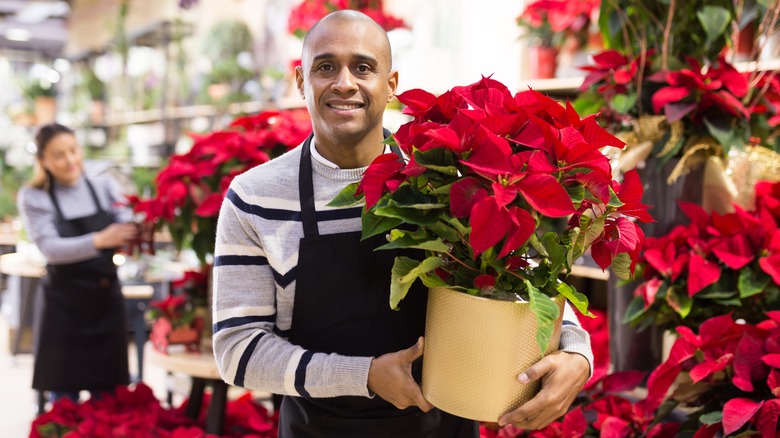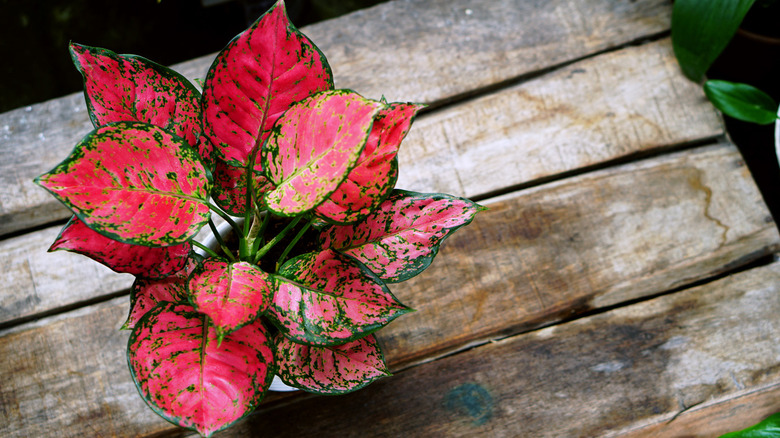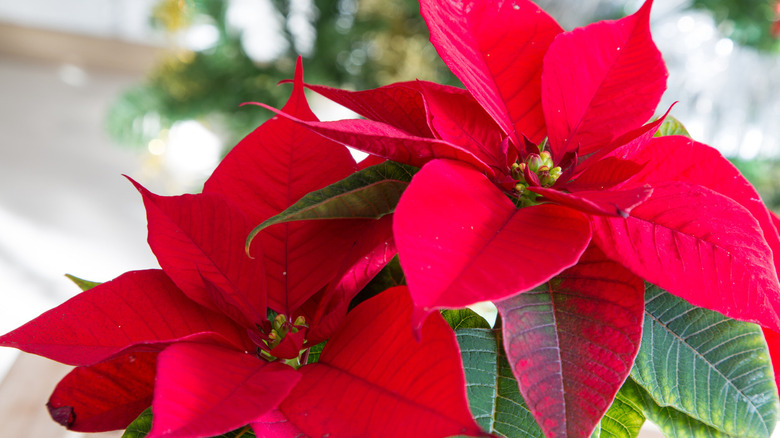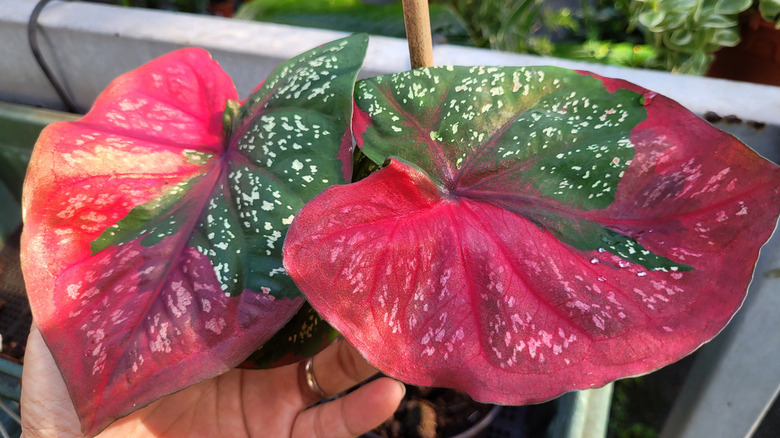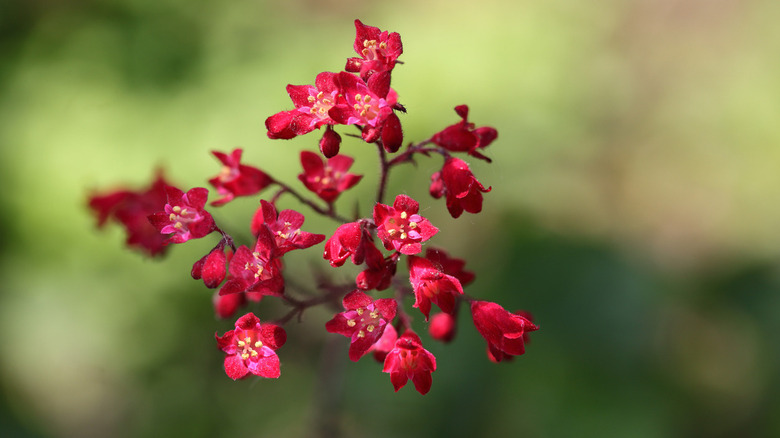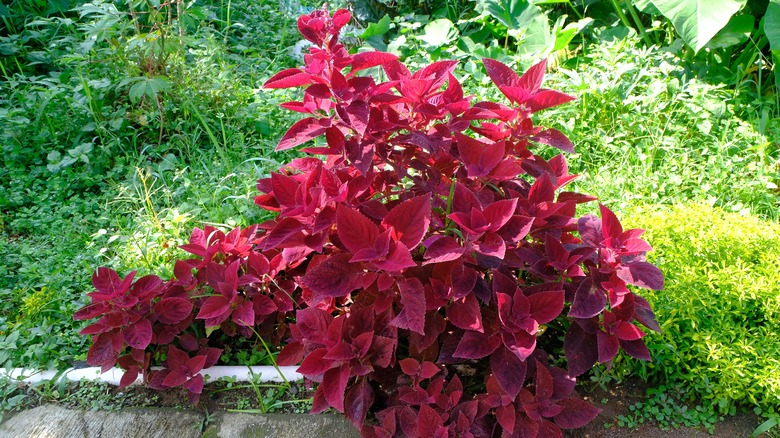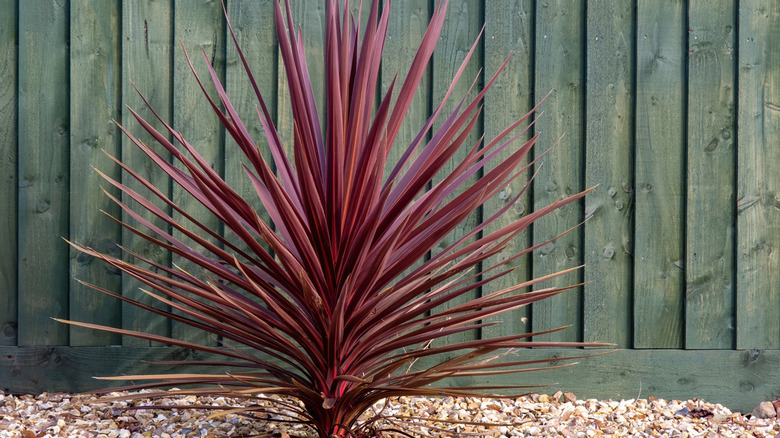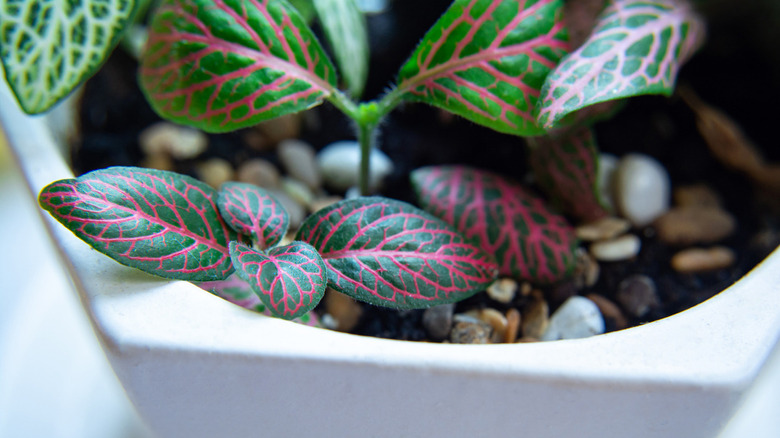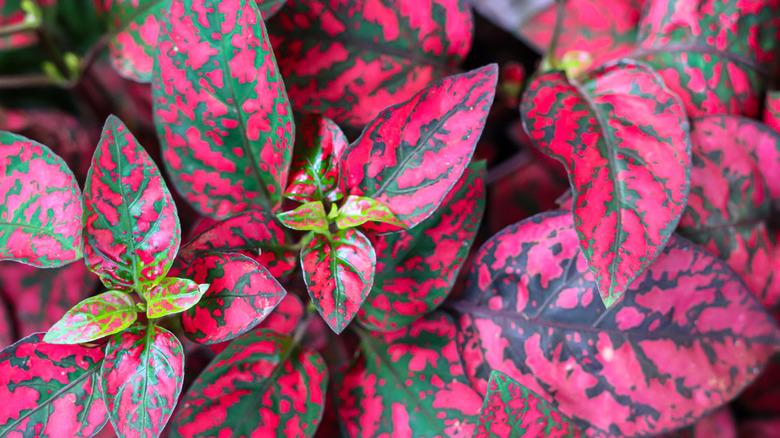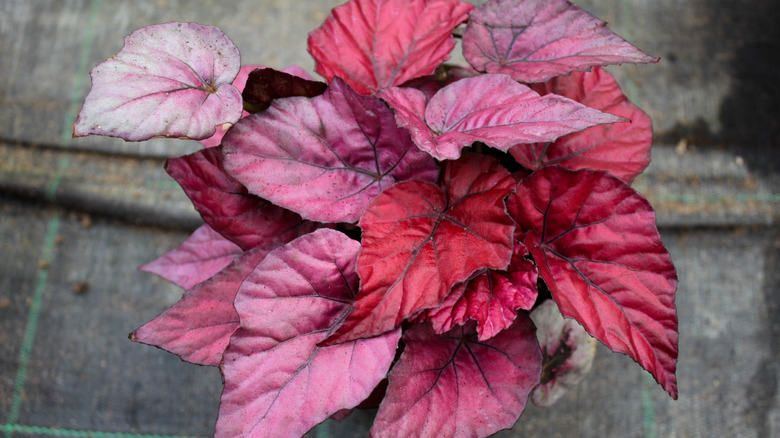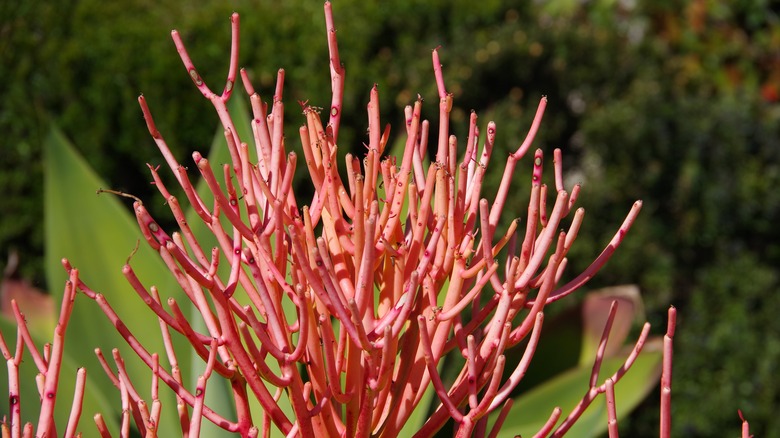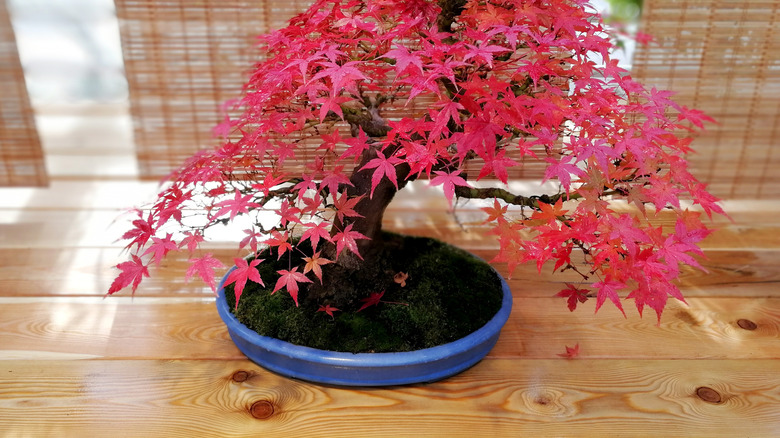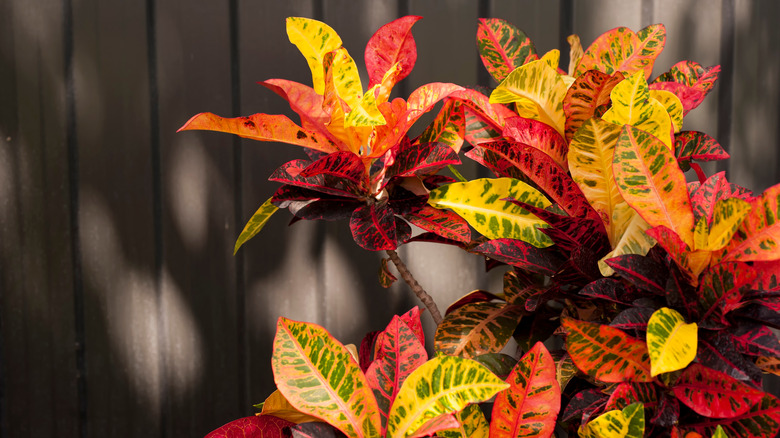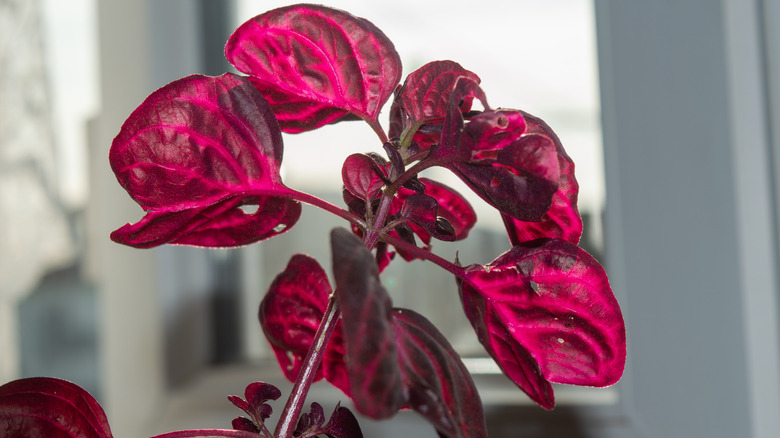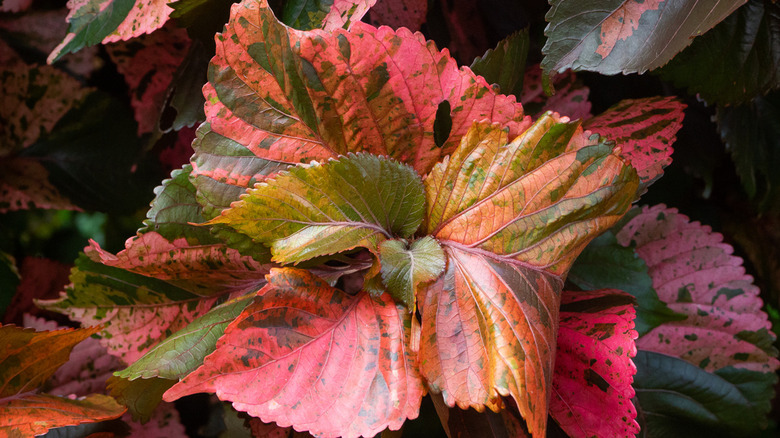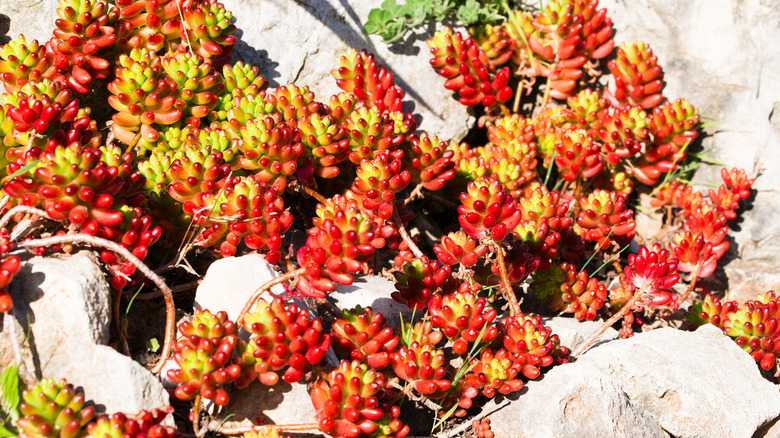15 Plants With Red Leaves Perfect For Your Indoor Space
Houseplants have become central to home décor today. Other than improving the aesthetic appeal of your home's interior, indoor plants are also associated with improving productivity and are also known to reduce psychological stress (via the Journal of Physiological Anthropology). Some people also consider houseplants as pets that cause no trouble. While there are plenty of cultivar options that you can go for, it is hard to beat the appeal of plants with red foliage.
These varieties have a way of introducing drama and a touch of warmth to the interior décor. In fact, the combination of red and green foliage creates a lovely contrast that you can use as a focal point in any space. So if you are in search of impressive houseplants with red foliage, you are in the right place. Unfortunately, finding the right variety is difficult enough, so here are 15 plants with red leaves that should help you find yours.
1. Red aglaonema
The red aglaonema, better known as Aglaonema commutatum or the Chinese evergreen, is one of the most popular colored houseplants. It features long, oval, and glossy foliage that may appear in different colors, including red. The Chinese evergreen is a slow grower and can be planted all year round, making it an ideal indoor plant. In addition, it is beautiful and relatively easy to take care of (via the North Carolina State University Extension).
Bloom Season: Spring, summer
USDA Growing Zone: 10-12
Growing Conditions: Full to partial sun exposure
Soil Type: Well-draining soil
2. Poinsettia
The poinsettia (Euphorbia pulcherrima) makes a nice indoor décor piece thanks to its striking bright red foliage. According to the University of Minnesota Extension, this plant changes color from green to red in response to the cold winter temperatures making it an ideal plant for Christmas. Other than red, poinsettia plants are also available in white and pink foliage, giving you options to match whatever décor you have.
Bloom Season: Winter
USDA Growing Zone: 9-11
Growing Conditions: Full to partial sun exposure
Soil Type: Well-draining, loamy soil
Size: 3-10 feet tall and 3-7 feet wide
3. Angel wings
The angel wings, also known as (Caladium 'Red flash') is a tropical plant that is purposely grown for its large and showy foliage. The surface of the leaves features a combination of green shade, red veins, and pink dots that are extremely eye-catching. This pot plant doesn't have stems; the leaves grow directly on petioles that emerge from the tuber underground (via the University of Wisconsin-Madison).
Bloom Season: Spring, summer, fall
USDA Growing Zone: 9-11
Growing Conditions: Indirect light indoors
Soil Type: Rich, well-draining soil
Size: 12-30 inches tall and 12-24 inches wide
4. Coral bells
Coral bells (Heuchera spp.) deserve a space in your home's interior; this plant features red foliage bound to introduce drama to any space. In addition, they are short-lived perennials that grow at a moderate pace, perfect for the indoors. The Missouri Botanical Garden recommends giving this variety enough direct sunlight with some shade in the afternoon, especially during the hot summer months.
Bloom Season: Spring, summer
USDA Growing Zone: 4-9
Growing Conditions: Full sun, part shade
Soil Type: Rich, well-draining soil
Size: 8-18 inches tall and 1-1.25 feet wide
5. Coleus
The coleus plant (Plectranthus scutellarioides) is another popular variety grown purposely for its foliage. This particular plant features a wide range of leaf shapes, sizes, and colors. It is also quite versatile because it can be grown either out in the garden or in pots. Despite having a wide range of colors, red varieties bring more life into your interior living space (via the University of Minnesota Extension).
Bloom Season: Seasonal
USDA Growing Zone: 10-11
Growing Conditions: Full sun to part shade
Soil Type: Rich, well-draining soil
Size: 6-36 inches tall and 6-36 inches wide
6. The good-luck plant
The good-luck plant (Cordyline fruticosa) is a tropical variety with beautiful palm-like leaves ideal for both the garden and indoor environment. It is quite popular as a houseplant thanks to the colorful and long-lasting foliage it has. However, according to the North Carolina State University Extension, the good-luck plant requires plenty of light to maintain its naturally beautiful leaves. As an indoor plant, it grows slowly, needing repotting every other year.
Bloom Season: Spring
USDA Growing Zone: 10-12
Growing Conditions: Partial sun
Soil Type: Rich, well-draining soil
Size: 2-10 feet tall and 3-4 feet wide
7. Nerve plant
The nerve plant (Fittonia albivenis), is another good option to explore as far as plants with red leaves are concerned. Although its foliage is predominantly green, it also features beautiful mosaic red veins that look amazing indoors. In addition, it is easy to grow, and the only requirements are protection from direct sunlight and watering whenever necessary. While the nerve plant may flower, it is popularly grown for its foliage, mentions the Missouri Botanical Garden.
Bloom Season: Summer
USDA Growing Zone: 11
Growing Conditions: Partial sun
Soil Type: Moist soil
Size: 2-5 inches tall and 12-18 inches wide
8. Polka dot plant
The polka dot plant (Hypoestes phyllostachya) is a tiny yet eye-catching pot plant grown purposely for its aesthetic appeal. The polka dot plant is available in several colors other than the typical pink spots, for instance, red and white, just to mention a few. The University of Wisconsin-Madison advises against exposing this plant to direct sunlight for good color development.
Bloom Season: Summer to fall
USDA Growing Zone: 10-11
Growing Conditions: Partial sun
Soil Type: Moist soil
Size: 1-2 feet tall and 1-2 feet wide
9. Rex begonia
The Begonia family has different varieties, but the rex begonia (Begonia rex-cultorum) has got to be the most attractive. This cultivar is popular for its showy leaves that are available in plenty of colors, including burgundy red (via the University of Florida Extension). In addition, rex begonias grow at a moderately slow pace making them perfect indoor plants.
Bloom Season: Not grown for flowers
USDA Growing Zone: 10-12
Growing Conditions: Partial sun to full shade
Soil Type: Well-draining soil
Size: 12-18 inches tall and 12-18 inches wide
10. Red pencil tree
Often mistaken for a cactus, the red pencil tree (Euphorbia tirucalli) is actually a tough succulent. The red pencil tree grows fairly slowly indoors compared to the wild. While its primary color is green, the North Carolina State University Extension mentions that placing it under direct sunlight turns the tips into a bright reddish hue. You should, however, take caution because of its toxic components.
Bloom Season: Spring, summer
USDA Growing Zone: 10-12
Growing Conditions: Full sun exposure
Soil Type: Sandy soil
Size: Up to 6 feet tall and 1-3 feet wide indoors
11. Japanese maple bonsai
The Japanese maple tree (Acer palmatum) features beautiful red foliage making it a popular candidate for the ancient artificial dwarfing techniques from Japan referred to as bonsai. These trees are often slow growers and don't require too much care and maintenance. One benefit of the Japanese maple bonsai is that it doesn't require direct sunlight to maintain the bright red foliage, mentions Bonsai Empire.
Bloom Season: Hardly blooms indoors
USDA Growing Zone: 5-8
Growing Conditions: Indirect sun exposure
Soil Type: Acidic, well-draining soil
Size: 60-80 inches tall
12. Croton
The croton plant (Codiaeum variegatum) is a popular houseplant grown purposely for its showy foliage. This evergreen perennial varies greatly as far as leaf colors are concerned, making it perfect for almost any interior décor. The common foliage colors include green variegated with other colors like pink, purple, or red, mentions the University of Wisconsin-Madison. They love the indoor environment with just enough sunlight and water to grow well.
Bloom Season: Any season
USDA Growing Zone: 11-12
Growing Conditions: Partial sun exposure
Soil Type: Well-draining soil
Size: 3-8 feet tall and 3-6 feet wide
13. Iresine bloodleaf plant
The bloodleaf plant (Iresine herbstii), is not quite as common but will be an interesting addition to your indoor plant collection. This short-lived perennial features purple-red leaves and stems that are bound to turn heads. When grown as a houseplant, it doesn't develop quite as tall as in the wild. The Missouri Botanical Garden mentions that the bloodleaf plant requires enough sunlight to maintain its bright colors.
Bloom Season: Doesn't flower indoors
USDA Growing Zone: 10-12
Growing Conditions: Full sun exposure
Soil Type: Well-draining soil
Size: 2-5 feet tall and 1-3 feet wide
14. Copperleaf plant
Among the plenty of plant varieties belonging to the Acalypha family, the copperleaf plant (Acalypha wilkesiana) stands out thanks to its bright, dramatic red foliage. The large serrated leaves come in different shades of variegated red color. The University of Arkansas Cooperative Extension Service mentions that this plant doesn't tolerate cold temperatures and will get a chilly injury if it falls below 40 degrees Fahrenheit.
Bloom Season: Year round
USDA Growing Zone: 10-11
Growing Conditions: Full sun, partial shade
Soil Type: Well-draining soil
Size: 4-6 feet tall and 6-8 feet wide
15. Pink jelly bean
If you are searching for a low-maintenance plant with red leaves, look no further than the pink jelly bean succulent (Sedum rubrotinctum). This low-growing plant with green and red fleshy leaves looks amazing on shelves or on a desk. The pink jelly bean loves the sun, making it a good option for the south-facing window as well. Despite their size and delicate appearance, these succulents tolerate harsh conditions and don't mind minimal neglect (via World of Succulents).
Bloom Season: Spring summer
USDA Growing Zone: 9-11
Growing Conditions: Full sun
Soil Type: Sandy soil
Size: 6-12 inches tall
